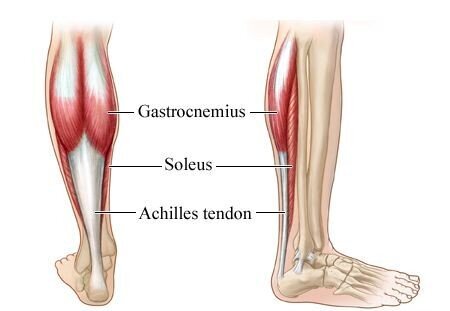Help! I keep getting tight calves when I run
A question we seem to always get asked by friends, family and patients is ‘why do my calves get so tight when I run? I try to foam roll and stretch but nothing seems to work’.
First, let us introduce you to your two main calf muscles.
Your calves are made up of a large variety of muscles, however we are only going to discuss the two largest muscles; the Gastrocnemius (Gastrocs) muscle and beneath that is the well-hidden Soleus muscle.
Both muscles play important roles in the running gait cycle. Their main role is to generate force for the push off phase of the gait cycle, this helps to propel you forward.
The Gastrocnemius (Gastrocs)
This muscle is made up of fast twitch muscle fibres which are used for sprinting and jumping. If you’ve pulled your calf after a hill sprinting session, it’s most likely this one.
The Soleus
This one is made of slow twitch fibres suited to long distance running and endurance activities. If you’ve experienced calf tightness during a long slow run, it’s probably this one.
“When running our calves absorb up to 6-7 times our body weight (1) This is why calf tightness is common among many types of runners, as they become weak and tired when exposed to repetitive loading. ”
In summary, to answer the questions above, foam rolling and stretching may relieve the symptoms in the short-term. However, for a long term fix you need to incorporate calf strengthening into your running regime to allow the calves to deal with the loading you expose them to.
Why does this happen?
There are a lot of factors that can be linked to causing weakness or strain in the calf muscles, we have listed a few below.
Poor training
This can be due to overtraining, neglecting recovery and increasing distance or speed too soon. We see this a lot of with recreational runners and people training for a specific goal in a short space of time.
Your biomechanics
This includes foot mobility and hips ability to extend, as well as muscle imbalances and tension. For example, the type of job you have may account to this if you drive or sit at a desk for long periods your hamstrings and hip flexors are shortened. These sorts of biomechanical issues can be assessed by your Osteopath, Physiotherapist or appropriate healthcare practitioner.
Muscle weakness
General weakness of the gastrocnemius, soleus, other plantar flexors and hamstrings result in poor endurance meaning they will tire quickly and may lead to injury.
Footwear
Did you know you should only run around 300-400miles in a pair of shoes, as the shock absorption will deteriorate and result in more load going through the calf muscle.
History of injury
Can be Achilles tendon, ankle sprain, muscle strains, plantarfascitis and fractures. Especially if you have already had a calf strain in the past.
Weight
The heavier you are the more load you are putting through your joints and muscles.
Temperature
Normally due to winter training and lack of warming up resulting in cold muscles which can lead to increased tension and restricted movement. So be sure to complete a dynamic warm up before heading out on your run!
Changes in running technique
Too large a stride length can lead to excessive knee flexion resulting in a higher risk of injury. Transitioning between running styles, for example, changing from heel strike to midfoot.
Something to try: To avoid over striding aim to keep your running cadence (Steps per minute) between 150-170 spm. Try using the Spotify playlist “Fun Run 150-165 bpm”.
Age
It seems to be more common in people over 30 (sorry!).
How do I know if my calves are weak and how can I improve this?
Find your bench mark calf strength:
Recreational runners (people who run 2-3 times a week) should be able to complete the following without stopping:
Double leg calf raises: 50-60 reps
Single leg calf raises: 25-30 reps
These should be completed first with a straight leg and then again with a slight bend in your knee (45 degrees), this will test the two main muscles in your calves. The straight leg calf raises test the Gastrocnemius, associated with speed training and the bent knee calf raises test the Soleus, associated with endurance.
If you are struggling to meet the mark, this indicates your calves aren’t strong enough to deal with the loading of running (remember you calves absorb 6-7 times your body weight when you run). Add straight leg and bent knee calf raises (double leg and single leg) into your strength routine on the days you aren’t running. For example;
Strengthening exercises for your training routine:
We recommend trying the double leg calf raises first (straight knee and bent knee), once you can comfortably complete 3 sets of 20 repetitions of this exercise, you can then progress to the single leg version of each. NB: The single leg calf raises are arguably more important as we are only ever loading through one leg when we are running.
Double leg calf raise (Legs straight = gastrocs):
Double leg calf raises (knees slightly bent: Soleus)
Single leg calf raises (Straight leg and bent knee examples):
Strength Routine (2-3 days a week):
Double leg calf raises (Straight and bent): 20 reps x 3 sets
If double leg are comfortable, progress to single leg:
Single leg calf raises (straight and bent): 20 reps x 3 sets
Once the above is comfortable you can progress by increasing the reps, sets or by adding weights. There are many more exercises that can be used to strengthen the calf muscles for running, but this is a good place to start!
But I already do calf raises?
If you are already able to complete a substantial amount of calf raises (single and double for each) on each side but are still getting tight calves, there are a few reasons for this.
You are more than a recreational runner.
If you run more than 3 runs a week and /or have some sprinting or hill sessions in there, your calves have a bigger load to withstand. For this level of running, you should be able to reach 45+ single leg calf raises per leg. If this still doesn’t make a difference, you may need to add some weight to your calf raises to replicate the force created during running. You can do this by holding dumbbells or by filling a backpack with something heavy (filled water bottles, tins of beans, etc). Reduce the repetitions while increasing the weight, for example 8 reps if using higher weights.
The issue is coming from somewhere else:
If your calves are tight but your strength is up to the mark, the cause of your calves overworking could be coming from somewhere else on the chain. For example, it may be due to issues related to the big toe, ankles, hips and/or hamstrings. This is where your chosen healthcare professional can help, they can help you to identify where the weaknesses lie and which areas need strengthening.


